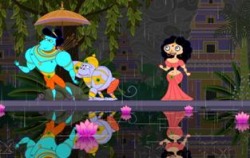Sita Sings the Blues
By Jaya Rao
March 18, 2010

UM| Rating: A-
As Indian cartoons go, there isn’t much of a high bar to pass, but this movie manages to be intelligent, thought-provoking, and mildly controversial at the same time. Sita Sings the Blues is a cartoon rendition of the Valmiki’s Ramayana, and the story itself contains four different lines of thought.
The first storyline drawn in squigglevision is the story of the writer herself, Nina Paley. After Nina’s husband got a job in India in real life, he called off their marriage of several years from there while she was in the United States. Nina’s story about how she was in love, tried to make the marriage work in India, and how she came upon the wisdom of the Ramayana is the first story line that comes to resolution at the end of the movie.
The second storyline is drawn in Pahari style painting, and it depicts episodes of the Ramayana. As the content of the episodes is played out, intermittent breaks take place where third storyline of shadow puppets of the narrators and collage pictures of Ramayana characters dissect the content and relevance of what is happening in the Ramayana from a modern South Asian perspective. Because several contemporary South Asian women view the Ramayana as an insult to women’s rights, the discussion gets heated but stays fun and light for the viewers.
The fourth storyline is what makes Sita Sings the Blues very unique. A singer from the '30s by the name Annette Hanshaw sings to her old songs from the 30’s as the voice of Sita, and Nina Paley has somehow inserted these songs within the tale of the Ramayana so that the content of the songs is relevant to what is happening in the plot. While the songs are sung, the background and characters all change to vector graphics animations.
What happens in the end is not meant to be suspense as many people already know the story of the Ramayana, but Nina Paley ends the movie on a mildly feminist note where the women of the storylines end up happier for being done with their ordeals and the men who were cruel to them during the course of the movie. Clearly this movie is not for the extremely devout or those who are unable to think outside the box of tradition to separate spirituality from religion. Many reviews from the more religious parts of India found this movie an insult, but it was received as a beautiful work of art in the big cities of India and most outside of India as well.
To watch "Sita Sings the Blues" see below for the full movie on YouTube and support the artist by visiting www.sitasingstheblues.com
As Indian cartoons go, there isn’t much of a high bar to pass, but this movie manages to be intelligent, thought-provoking, and mildly controversial at the same time. Sita Sings the Blues is a cartoon rendition of the Valmiki’s Ramayana, and the story itself contains four different lines of thought.
The first storyline drawn in squigglevision is the story of the writer herself, Nina Paley. After Nina’s husband got a job in India in real life, he called off their marriage of several years from there while she was in the United States. Nina’s story about how she was in love, tried to make the marriage work in India, and how she came upon the wisdom of the Ramayana is the first story line that comes to resolution at the end of the movie.
The second storyline is drawn in Pahari style painting, and it depicts episodes of the Ramayana. As the content of the episodes is played out, intermittent breaks take place where third storyline of shadow puppets of the narrators and collage pictures of Ramayana characters dissect the content and relevance of what is happening in the Ramayana from a modern South Asian perspective. Because several contemporary South Asian women view the Ramayana as an insult to women’s rights, the discussion gets heated but stays fun and light for the viewers.
The fourth storyline is what makes Sita Sings the Blues very unique. A singer from the '30s by the name Annette Hanshaw sings to her old songs from the 30’s as the voice of Sita, and Nina Paley has somehow inserted these songs within the tale of the Ramayana so that the content of the songs is relevant to what is happening in the plot. While the songs are sung, the background and characters all change to vector graphics animations.
What happens in the end is not meant to be suspense as many people already know the story of the Ramayana, but Nina Paley ends the movie on a mildly feminist note where the women of the storylines end up happier for being done with their ordeals and the men who were cruel to them during the course of the movie. Clearly this movie is not for the extremely devout or those who are unable to think outside the box of tradition to separate spirituality from religion. Many reviews from the more religious parts of India found this movie an insult, but it was received as a beautiful work of art in the big cities of India and most outside of India as well.
To watch "Sita Sings the Blues" see below for the full movie on YouTube and support the artist by visiting www.sitasingstheblues.com
